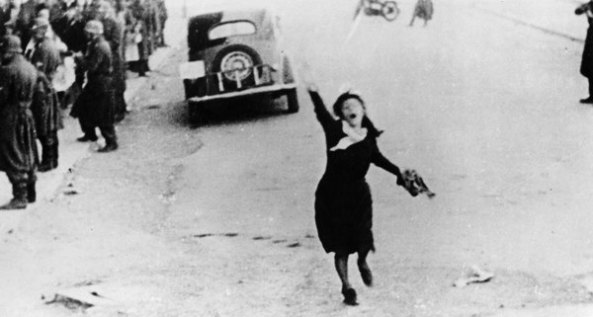Luis Bunuel opens his 1953 film “Los Olvidados,” or “The Young and the Damned,” with a disclaimer that explains his film is true, not optimistic and leaves everything to society’s progressive forces to solve. The film is about the poverty, crime and hardship that’s befallen Mexico as a result of the institution. It could very well be the same description as Roberto Rossellini’s “Rome, Open City.”
With “Rome, Open City” in 1945, Rossellini effectively invented the film movement known as “neorealism.” These films shot on location with non-actors and focused on ordinary lives as they were in the world. And starting in 1945 immediately after the war, Rossellini’s War Trilogy that included this film, “Paisan” and “Germany Year Zero”, were scathing indictments and portraits of the Italian lifestyle that had grown out of the war. Its early protagonist Pina (Anna Magnani) is the fiancee of an Italian insurgent named Francesco (Francesco Grandjacquet), and his associate going under the alias Luigi Ferraris (Marcello Pagliero) is being hunted by the Nazis.
But mostly, their casual scheming and getting around officers is a way of life. We see kids playing football in an alley, hiding rebels, talking on the phone with the certainty that the Gestapo are listening, and parenting with all the salt of an Italian household. Even the kids take an involvement in the war, sneaking home late under a secret underground pathway of rubble after staging an explosion on the far side of town. There’s a beautiful shot of them returning home that highlights the poverty and the valor that came out of the war effort.
In that way it is as much a class drama as it is a historical document. But the movies were never the same after “Open City’s” most famous scene. It’s a mad dash, a passionate moment of love and devotion and a cruel, bitter fate for an ordinary woman. The scene redefined what drama could look like and how spontaneous it could be.
Rossellini’s films had international appeal that required the director and others to explain to early audiences what they had just seen. But they were so well received that “Open City” came away with an Oscar nomination.
One who of course had his ear to the ground was Bunuel. “Los Olvidados” was made in answer to the neorealism movement, questioning why a film about reality couldn’t include elements of fantasy. His film is as down to Earth as it gets, with poverty across Mexico City, rendering whole families in tiny, single room homes or kids wandering and working the streets at makeshift merry go rounds and swing sets.
But the monsters of Mexico City as Bunuel sees them are only somewhat redeemable humans. He promises this is all true, but their actions resemble that of another, less civil world. Early on he paints one child as a ravenous bull pantomiming as part of a rodeo. Later we witness this pack of kids terrorizing a blind man and a disabled man with no legs. He travels by riding and pushing himself on a cart, and the punks rob him blind and send his cart down the street.
“Los Olvidados” follows two boys most prominently, the young Pedro (Alfonso Mejia) and the tall, troublesome Jaibo (Roberto Cobo). Jaibo recently ran away from his reform school and is back terrorizing the streets and the cute farm girl Meche. He ends up confronting Julian, who he suspects ratted him out and put him in reform school in the first place. But what was supposed to be a simple surprise attack ended up as a murder, and Pedro a reluctant accomplice.
“Los Olvidados” is Pedro’s story of attempted reform, but even his mom won’t have him home to feed him. He tries getting a job as a blacksmith’s apprentice, but Jaibo steals a knife and Pedro loses his job as a result. It all comes to a climax when Bunuel truly shows his hand, a dream sequence that conjures up old cinematic tricks of ghost stories and spectral, slow motion. In his sleep, Pedro he sees a bloodied Julian pleading for his life. He begs his angelic mother for food, and she brandishes an entire shank of meat. As she nears him, Jaibo’s hand seems to burst from hell and steal it away.
While both Bunuel and Rosselini hold a mirror up to the world, only Bunuel makes us implicit. His dream sequence does the job of invoking higher stakes on his story than just a social problem film. And in a quick sequence late in the movie, Pedro hurls an egg at the camera as an assault on the audience as well as authority. Rosselini’s imagery is no less powerful however. “Rome, Open City’s” final scene is the assassination of the town’s beloved priest Don Pietro (Aldo Fabrizi). He’s brought in front of a firing squad and killed, but not before the children as part of his class stand by a chain link fence and watch, forever branded, changed and compelled to rebellion at the sight.
“Rome, Open City” and “Los Olvidados” find the basest expressions of humanity and trouble in the children on the streets and the surrounding poverty and institution. They’re as right to call these films pessimistic as they are to call them real.

